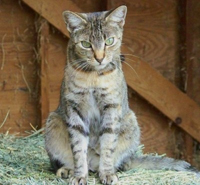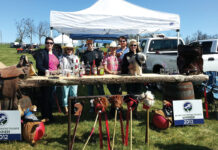 Got mice? Besides securing the lids of grain bins and sweeping up leftover pellets, you can cut down on unwanted rodents by recruiting the services of a barn cat. A recent article in the Los Angeles Times revealed the Los Angeles Police Department controlled a burgeoning mouse problem in its warehouses by putting feral cats to work patrolling the buildings.
Got mice? Besides securing the lids of grain bins and sweeping up leftover pellets, you can cut down on unwanted rodents by recruiting the services of a barn cat. A recent article in the Los Angeles Times revealed the Los Angeles Police Department controlled a burgeoning mouse problem in its warehouses by putting feral cats to work patrolling the buildings.
Over the years Erin has helped re-home many feral cats in to barns. “While it’s wonderful if a feral cat ends up becoming totally tame, the older ones have grown up having to fend for themselves. Many of them aren’t likely to ever be a true pet in the sense of picking it up and carrying it around. So when we can place them in a barn setting, where they’re cared for but they’re allowed to still be ‘free’, it’s like, ‘Wow! We hit the jackpot with this home!’”
If you have noticed feral cats lurking in the fields surrounding your stable, and you’d like to invite one or more to stay there permanently, Erin offers three quick tips.
She begins by explaining, “There is already some sort of food source nearby or the cats wouldn’t be in the area. But you can lure them to the barn if you put out food. You have to be careful, though. If the food is disappearing and you don’t spy a feral cat sneaking up and eating it, you might be feeding other animals you don’t want around a barn, like raccoons and opossums.”
Once you have a cat who’s come to dinner, you have to trap it so it can be spayed or neutered and vaccinated. After all, you need to be responsible for the cat’s welfare and you certainly don’t want to add to the feral cat population.
“Contact a cat rescue group, the local branch of the Humane Society or your animal control department. They’ll be able to loan you a humane trap and explain how to bait it,” Erin says. “They can also refer you to a low cost spay-neuter clinic or a vet who is willing to work with feral cats.”
Finally, once you have your official barn kitty, you need to provide shelter. Simply assuming it’ll find a bed in an empty stall or snuggle up in the hay loft isn’t good enough.
“They really like having an area where they feel safe and secure,” Erin explains. “An easy home is to buy a big rectangular plastic tub, like a Rubbermaid. Cut a large opening in the side. Turn it upside down and set it out of the barn’s traffic area. Then place some straw inside or other warm bedding material, like maybe an old flannel or fleece blanket. Some people also insulate the outside in really cold weather. Eventually, the cat will discover the home and use it as its den.”
Of course, you’ll still need to continue to feed the cat to keep it around. Otherwise it’ll go seeking a more reliable food source. Yet don’t worry that by feeding the cat it’ll stop hunting vermin. “That’s a natural instinct,” Erin says. “And remember, just having a cat around will help keep the mice away.”
After you’ve welcomed a feral cat into the stable, you and your horses can enjoy the benefits of a barn cat. Plus, you’ll have the satisfaction of having given a forlorn feline a good home.







My barn made the mistake of not spaying our barn cat. They adopted her from the humane society & she fit right in to our side of the barn, but on the other side of the barn lived an unspayed male cat. They me & Momma Cat soon had a litter of 5 tiny kittens. No one knew she had the kittens, so the poor cats were never tamed. They ran away & are only seen every now & then. Before they could spay Momma cat she went off & got pregnant again. This time the kittens were kept in the tack room where there are plenty of mice. We trained them to use the litterbox & since Mom knew how to open the door she could come & go as she pleased. My instructor scheduled Momma cat to get spayed as soon as the kittens were 6 weeks old. All the kittens got good homes, but the week before the kittens turned 6 weeks old, Momma cat got pregnant again. Momma cat is now spayed & we are kitten free! We are also mouse free too! So don’t make the mistake of not spaying your barn cat because they can & will find a way to start a family!
Good article! Cats are great at keeping the mice down. And the more animals the merrier, right? 🙂
We HAD a mouse problem, that is, until my Jack russle terrier
at terriermix found out. We do have a barn kitten, (a siamese without a tail) but he does not even make the mice flinch, he sleeps all the time, and our other cat doesen’t even go in the barn.
I’m not really a cat person, but I love our barn cats. Our horses like the cats, too. Good article with good advice.
At the barn where I ride there are lots of cats! They have at least 7 cats that I can think of. They are are very friendly, and will coming running up to you as soon as you get out of the car, and will sometimes try to get in the car! 🙂 It wouldn’t be the same without them!
My trainer did the trap and spay thing with the feral cats around her barn, but most of the time she kept trapping her own pet cat! I think he gained about 10 pounds! But she finally ended up with several very nice barn cats. And no mice.
Our mice disappeared after a kitten was dumped on our farm. She is the friendliest cat ever, and tries to “help” when we’re working outside.
She is a real hunter. I’ve seen her stalking crows, an eagle, and last year, during hunting season, she tried to drag my cousin’s deer out of the bed of his truck. She loves it when we hunt pigeons.
i’ve adopted ferals and rescued unwanted kittens to patrol the barn. i have never found one that would sleep in a shelter made for them. they want to be up high looking down. i wouldn’t waste my time making a “house” for them. they are ingenius in finding shelter. some faves around my open barn area…in the wooden cubby hole compartments in the barn aisle, under a wheelbarrow leaned up against the feed building, of course the hay stacks and underneath the storage building. remember it’s important to feed your cats. some people tell me you don’t have to but they may not stay around. my current barn cat is 6 years old.
I’m tired of mice in my barn. I’m getting a cat this spring!
Where i ride we have 3 barn cats! THe thing is I think my trainers dog is more intrested in chasing the mice then the cats! But my cat at home is a great hunter! I think it pays off to have them exspecley when they r rescued!~m
I find that the barn cat at our stable likes to sleep on the saddle blankets.
This is great news for the cats. I have several that love hanging around my horse and he enjoys them too.
My horse loves cats we have about a dozen so not trouble with mice and three feral cats.
We have 8 barn cats that hang out around the stables. They have grown up in our barn since they were kittens so they are all as tame as ever and love attention, especially being held. They get along with our horses perfectly and are always showing off the mice they catch to us.
we went from 12 cats at our barn a few years ago, then the cat population dropped to about 5 cats now our cats decided to raise it up to currently 11 cats!
I love barn cats. Most of my eventially like to come to the house once they’re tame, but the feral ones still hang around. I try to catch most to spay & neuter.
Really good article. Our animal rescue organization has had a lot of luck placing otherwise unadoptable cats in barns. We recently produced a “How to acclimate barn cats” video and posted it on our site:
http://www.sheltermeinc.org/shelter-me-barn-cats-how-to-acclimate/
It features before-and-after placements in barns across New England.
it was very insightful i usually hate feral cats but this is a good way for them i also like the little tip on how to give them a din to make their own
thanks for the article
A friend of mine needs to re-locate 3 scared fixed cats from where they are living outside to a safe barn, due to tearing down the building on their property. Are you able to give any advise as to how to find a barn in Ontario that may want to give them a safe barn home?
Super, super article! I manage a feline rescue,www.freeroamingfelineprogram.com near Manitowoc, Wis. and feral Roamers that we placed in horse barns when we first started in ’08, are still “hunting” in their “new” locations. Many farmers and horse barns have run their outdoor felines through our program.